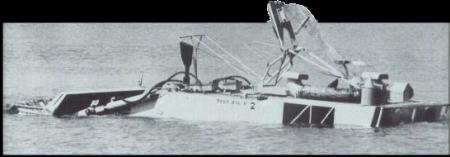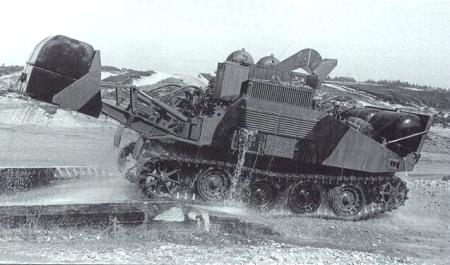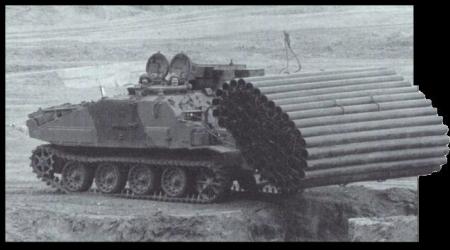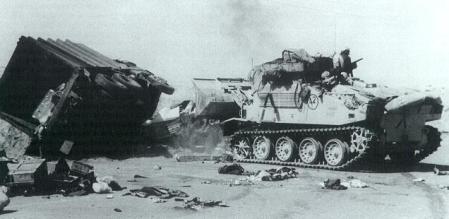| Specification
|
Photo Gallery
|
Photo Gallery
4 |
Model Gallery
|
| Specification
2 |
Photo Gallery
2 |
Photo Gallery
5 |
Model Gallery
2 |
| From
CMV 3/1 |
Photo Gallery
3 |
Photo Gallery
6 |
Reserved
|
    |
Photo Gallery
2 |
 Test Rig No.2 is shown here afloat. Painted bright yellow, it was an ugly looking brute at best. The body was little more than a large box, Rigged on top is the rocket-launched earth anchor which, when attached to the winch cable, assisted the vehicle to climb out of the water. These prototypes were powered by a 350bhp Cummins V8 diesel. |
|
 A Production CET
emerges from the wading tank at Gallows Hill, Bovington during a
demonstration. The shape of the body has been altered considerably, but
this also affected the inherent buoyancy. Once in the water, CET is
powered and steered by twin Dowty water jets which will push it along at
about 6 mph, water can been seem draining from the right side water
intake, the grille of which is protected by an armored cover during normal
land operations. A bilge pump is also fitted to offset leakage. The role
of CET during river crossing involves using its amphibious capability to
swim across, then deploying the rocket-launched anchor and winch to haul
itself out on the opposite bank. Once established there, it would use its
bucket to create a ramp into the water so that other vehicles would have
an easier exit. A Production CET
emerges from the wading tank at Gallows Hill, Bovington during a
demonstration. The shape of the body has been altered considerably, but
this also affected the inherent buoyancy. Once in the water, CET is
powered and steered by twin Dowty water jets which will push it along at
about 6 mph, water can been seem draining from the right side water
intake, the grille of which is protected by an armored cover during normal
land operations. A bilge pump is also fitted to offset leakage. The role
of CET during river crossing involves using its amphibious capability to
swim across, then deploying the rocket-launched anchor and winch to haul
itself out on the opposite bank. Once established there, it would use its
bucket to create a ramp into the water so that other vehicles would have
an easier exit.
|
|
 Under normal circumstances, CET travels with the bucket at the rear, although the two crew members, sitting in tandem, can control the vehicle independently as required. Here both men can be seen with their hatch covers open as they use the bucket to drop a pipe fascine into the gap. The fascine, which is no more than a loose bundle of plastic pipes, will fill a deep ditch and support other vehicles that cross over. Should the ditch be full of running water these pipes will not interrupt the flow. The bucket has a capacity of 62 ft3 when use for earthmoving, and can be used to create fire positions for other vehicles, as a bulldozer or grader for road making or even as an earth anchor when winching. For normal road operations, CET relies on controlled differential steering but the driver also has the option of switching to clutch and brake system to skid steer the vehicle when acting as an earthmover or bulldozer. It is also possible to lock the end suspension units when this work is being done to ensure that the bucket is not forced to ride over its load instead of scooping it up. The bucket is operated hydraulically by the second crew member. It is constructed of aluminum alloy with a vicious looking row of steel teeth along the lip. |
|
|
|
|
|
|
|
 Combat Engineer Tractor was used during the Falklands War and again the Gulf conflict. This CET, with 32 Armored Engineer Regiment, Royal Engineers, pushes an abandoned truck off the road. The crew are provided with personal weapons. The Sappers carried out a number of experiments on vehicles in the Gulf, one of which involved fitting two explosive pipe charges to the bucket of a CET for demolition work. Naturally a machine like CET is invaluable in areas like the Balkans and it has served in United Nations colors in Bosnia and subsequently with SFOR and KFOR. Abroad, the armed forces of both India and Republic of Singapore have purchased Combat Engineer Tractor. |